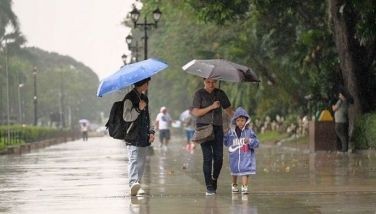Rainy, cooler All Saints' Day
MANILA, Philippines - No tropical cyclone is expected to affect the country on All Saints’ Day but the state weather bureau yesterday advised the public, particularly those in eastern Visayas and the Bicol region, to bring umbrellas as rains will prevail over these areas due to the intertropical convergence zone.
Robert Sawi, chief of the Philippine Atmospheric, Geophysical and Astronomical Services Administration’s (PAGASA) weather division, said the northeast monsoon – associated with slightly cooler temperatures – will prevail over the country in the next five days.
In a press conference, Sawi said provinces in the eastern sections of Luzon, including Cagayan, Isabela, Quirino, Nueva Viscaya, Nueva Ecija, Aurora, Quezon and the Camarines provinces, will experience light rains starting today until Nov. 2.
He said warm and humid weather will prevail over the rest of the country, including Metro Manila, aside from isolated rains and thunderstorms in the afternoon or evening during the outlook period.
Sawi said the eastern section of the Visayas, Bicol region and Mindanao will experience widespread rains on Nov. 1 and 2 due to an approaching low pressure area.
But Sawi said the low pressure area, which is embedded along the intertropical convergence zone, is unlikely to become a cyclone.
The weather official warned the public in the Visayas, Bicol region and Mindanao against possible flashfloods and landslides.
He also advised the public not to venture into the seas of Northern and Central Luzon as big waves will affect the areas due to the surge of the northeasterly wind.
Meanwhile, Anthony Lucero, officer-in-charge of PAGASA’s Climate Monitoring and Prediction Section, said most parts of the country especially the eastern sections will likely experience “near to above normal” rainfall conditions.
However, Lucero said that latest models showed that the 2011-2012 La Niña “is weaker than the strong 2010-2011 La Niña.”
“The current cooling of the Pacific Ocean waters can be classified as weak compared to last year’s La Niña,” he said.
Lucero said La Niña, which is characterized by excessive rainfall, will affect the country’s climate during the remaining months of 2011 up to the first quarter of 2012.
He said the areas that are expected to experience above normal rainfall this November are the Cordillera Administrative Region, Regions 1, 2, 6 and Mindoro provinces.
Lucero said two or three more tropical cyclones are expected to enter the country before the end of the year.
A total of 18 cyclones have entered the Philippines so far this year.
- Latest
- Trending































